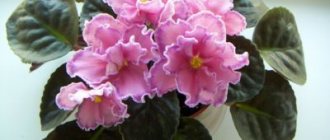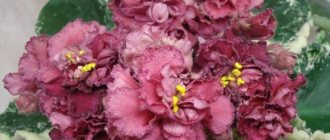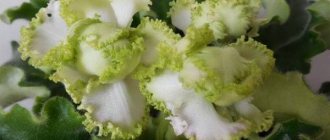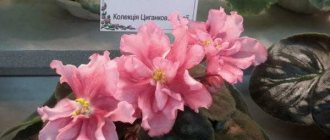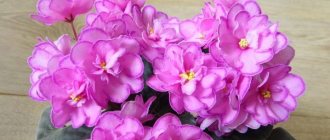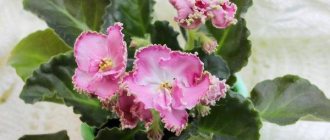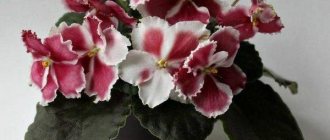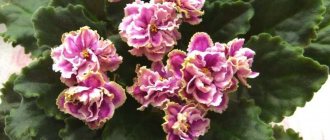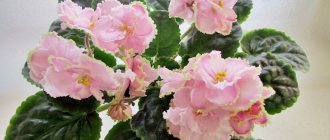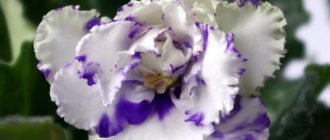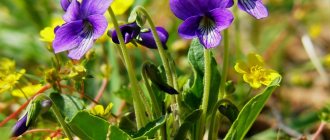Among the many unimaginably beautiful varieties of violets, every caring gardener can find a beauty to his liking.
However, before purchasing, you should make sure that you can provide the plant with optimal conditions.
Saintpaulia LE-Vivien Leigh is an exquisite princess among violets , a real treasure for lovers and collectors that requires careful care.
Violet LE-Vivien Leigh (E. Lebetskaya)
Genus, family
The variety belongs to the Uzambara violet (Saintpaulia) family of the Gesnerieceae genus.
Origin story
The variety was created by an excellent violet breeder E. Lebetskaya . It is named after the actress who played the unforgettable Scarlett in the film Gone with the Wind.
Photo and description of the variety
Magnificent flowers of a pure cream color with a curly pink border, with soft light green “lace” at the very tips . The petals have an exquisite corrugated texture, very terry , and a complex, whimsical shape.
Peduncles grow in the center of the rosette. Just a few large buds, about seven pieces, create a luxurious bouquet. The flowers are simply huge, 7 centimeters in diameter !
The leaves are smooth, rounded, with a convex pattern of veins and teeth along the edges. In a young plant they stretch upward, but with age they drop beautifully.
Variegation, imprints
, star-shaped rays of a crimson hue scatter across the petals . Such prints are a special advantage of the colors of this variety.
Violet SM-Legends of St. Petersburg (Seedling Morev)
Exquisite violet Legend of St. Petersburg.
Authorship of the variety
Not all seedlings obtained in the process of breeding work adequately pass the complex stages of testing for registration as a variety. Most of these violets are discarded and subsequently destroyed. But some specimens, having positive characteristics and spectacular decorativeness, still end up in the collections of violet growers, thanks to which they receive:
- Original name;
- And the opportunity to participate in exhibitions.
This path was taken by the seedling “SM-Legend of St. Petersburg”, bred by Moscow breeder Konstantin Lvovich Morev . One of the leading specialists in the national school of breeding has been doing what he loves for almost a quarter of a century, creating masterpiece varieties of Saintpaulia and no less beautiful seedlings.
This variety was developed by Konstantin Morev.
The impetus for this hobby and comprehension of the main principles of the breeder’s work was an acquaintance with the master of Soviet violet growing B. M. Makuni .
ATTENTION! The violet has taken root in indoor culture and has been performing splendidly at exhibitions since 2013, differing from varietal specimens only in the abbreviation “SM” (Moreva seedling), but not in appearance.
Taxonomy of the variety
Saintpaulia “SM-Legend of St. Petersburg” in the unspoken status of a “seedling” and with a popular name, falling under the official hierarchical principles of taxonomic periodization of botanical objects, belongs to the magnificent selection of color shades and scattering of silhouettes, impressive in the quantitative expression of the presented variations and chic in decorative qualities of the Saintpaulia family (from the Gesneriev family):
- According to the average values of their overall diametrical coefficients, bushes represent a standard group;
- And according to the color chart, it is a fingered subspecies.
The variety belongs to the finger subspecies.
Photo and description of the variety
The seedling belongs to a fairly large subgroup of Saintpaulias, which :
- They are not difficult to maintain;
- And they have an unpretentious behavior regarding grooming.
Its important, characterizing feature, which flower growers especially focus on when choosing a variety for a collection, is the ability to independently form the contours of a bush.
With the beginning of the formation of young leaf plates, violet carefully distributes them according to the principle of constructing mosaic patterns in several even tiers, which provides the seedling with:
- Symmetrical configuration;
- And a fairly dense structure.
The seedling in its dimensions is considered a classic of the standard Saintpaulia varieties, but in the first life phases it is able to increase its size almost to the maximum limits of the standard type due to the elongated leaf petioles. The rosette at this stage may have a slightly loose structure.
IMPORTANT! With age, the petioles return to optimal performance, and the problem of the size and looseness of the bush is solved without unnecessary worries.
Medium-sized violet leaves have :
- Oval shape with slight;
- Smoothly pointed at the end;
- And a smooth, shiny surface texture with symmetrical venation graphics, standing out with a light salad color against the background of the general tonality of spring greenery.
The contours of the sheet plates are different :
- Wave-like configuration;
- And with slightly outlined teeth, a smoothly rounded shape.
The leaves of Saintpaulia are wavy.
Flowering of the seedling occurs in the usual time frame for most representatives of the genus, characterized by :
- Creating large volume hats;
- The appearance of flowers of significant diameter;
- And the course of the whole process in a very stormy mode.
The flowers of the seedling are huge “stars”, simple or semi-double in density structure . Corollas of different types are rarely found together on the same rosette. Additional curliness is given to the flowers by the lush frills that decorate the edges of each petal - in total this creates:
- Extremely unusual flowering configuration;
- And a spectacular decorative silhouette of the entire bush.
In terms of color type, the seedling is a representative of the original digitose subgroup of Saintpaulias . The main white color of its petals is almost completely covered by lilac-burgundy central prints, the shade of which gradually flows into a violet tone when moving towards the edge.
As a result, a white central star is clearly visible , spreading rays along the side edges of the petals, and white lace along the frilly edge, shading the whole picture.
The center of the flowers has white stars.
Sports
IMPORTANT! It is wrong to talk about the emergence of sports in relation to a seedling, since these violets do not have a fixed description and can easily and without consequences change their characteristics.
Although the seedling has not been recognized as a variety, it maintains its characteristic corolla color range quite consistently, without showing any obvious changes in shades.
Home care
There are no author's recommendations on the content of the variety, so it is best to rely on general recommendations for growing violets.
Conditions of detention
Saintpaulias need bright, diffused light because the ancestors of indoor plants grew in the shade of shrubs:
- it is easiest to achieve suitable lighting on a south, east or west window , covered with blinds to protect from direct sunlight;
- On northern windowsills, violets gain green mass well, but rarely bloom.
Proper watering and fertilizing
Watering is an important part of care. You need to water it about once a week with clean, settled water . You can water from above or into a tray.
In winter, reduce watering so that the soil in the pot has time to dry out a little between waterings.
Fertilizing is carried out together with watering , fertilizers are added half as much as in the instructions, every second watering. Special fertilizers for violets are suitable. A meager but constant supply of minerals is the best way to feed Saintpaulia.
Advice! In the summer, during the hottest time, tear off the buds, try to humidify the air and transfer watering to the evening. These measures will protect the plant from depletion.
Lighting and temperature
If the leaves stretch upward and look at the ceiling, the violet does not have enough light. In winter, you can use additional lighting with a lamp. In summer, it is enough to move it closer to the window, not forgetting about protection from direct sunlight.
Violets older than two years bloom profusely at 20-25°C . Before this, the violet will grow better in warm conditions - 23-25°C. If we consider 18-20 degrees cool and 30-35 hot, cool is definitely better.
Reminder on the temperature of keeping violets.
At lower temperatures, growth slows down, in the heat the plant can get leaf burns, flower stalks grow short and deformed .
Attention! Sudden temperature changes are detrimental to Saintpaulias! Be careful with vents in winter.
Air humidity
A humidity level of at least 50% is recommended The best option is a humidifier. An additional container of wet sand or a mini-aquarium with sphagnum moss also works well to increase the humidity level.
What kind of soil does he prefer?
Loose, slightly acidic soils with good water and air permeability. Compound:
- peat;
- charcoal or ash;
- vermiculite or perli;
- the base is leaf soil.
Pruning and hygiene
It is necessary to regularly remove the lower leaves, which have turned yellow and have lost their elasticity , so that fungi do not develop on them.
The violet can be washed under a weak, lukewarm shower no more than once a month.
After bathing, leave the Saintpaulia in the bath for a couple of hours until the leaves dry. In the light, drops of water may leave unsightly brown spots - burns.
Reproduction methods
Children
The easiest way to reproduce. Babies are a tiny plant grown on a stem, broken off by hand and planted in a small pot with moistened soil. This plant is called starter. To get established better, build a greenhouse from a transparent cup or bag.
Leaf, cuttings
Each vein of the leaf blade has a growth point from which a new Saintpaulia can grow. Sequence of procedure:
- Prepare a container with moist soil and a material from which you can make a shelter (film or cellophane);
- Immerse the leaf stalk into the soil about a centimeter (if necessary, you can support it with a match so that it does not fall);
- To get many starters from one leaf, it is cut into fragments so that each has a section of vein, and the cut is pressed to the ground;
Propagation by leaf fragment. - The greenhouse is covered with transparent material for constant humidity;
- In three to four weeks, sprouts will appear from the ground - these are new violets;
- When they get stronger and grow five to six leaves, it’s time to plant them in an individual container.
Advice! For starters, choose small pots, no more than 6 centimeters in diameter, to see the first flowers faster.
Not all starters will resemble the mother plant. Those that are very different are called sports from the variety.
Transplant rules, rejuvenation
The stem of Saintpaulia grows all its life and one day the top begins to fall out of the pot. Then she needs to be rejuvenated.
To restore beauty and youth to the rosette, the top needs to be cut off at an angle and planted in a container with new soil. It will soon take root and begin to bloom in about three to six months.
Mature violets take about a year to extract nutrients from the soil, so they need to be replanted in fresh soil every spring .
Contents in room culture
Violet growers consider the seedling to be an undemanding variety of Saintpaulia with an easy character - it simply gets used to the microclimate of a particular room, develops quickly and blooms very rapidly, thus responding favorably to classical agricultural technology in its maintenance, subject to careful implementation of all regimes :
- It is correct to place the seedling on a western or eastern window; specimens on northern windows require additional lamps with a diffuse spectrum; on southern windows, artificial shade is required;
- Water stands in small volumes when the effect of light drying appears at the upper tier of the substrate;
For good flowering, violets require proper care. - Additional mineral fertilizers should be used based on the decorative appearance of the violet;
- lighting that is mostly natural, long-lasting and diffused;
- Suitable temperature is within the range of +20 + 24°C, excluding sudden fluctuations in indicators;
- Seedlings should be planted using nutritious, permeable soil with good aeration and a thick layer of drainage;
- When transplanting, use transshipment more often, except in special cases;
- Humidity indicators should be corrected by any possible means; only spraying the violet is not permissible.
Features of growth and flowering
Development at home
Room temperature and humidity are quite comfortable for violets. Provide indirect light and they will bloom most of the year. In winter, it is enough to slightly increase the humidity and protect it from drafts - that’s all the violet needs.
How long does it take to grow an adult plant?
The starter grows foliage and root mass for about a year , then it begins to bloom and can be considered an adult violet.
Attention! Violets do not bloom in large pots! A pot diameter of no more than 9 cm will quickly fill with root mass and then buds will begin to appear.
Specifics of flowering in hot and cool conditions
At temperatures up to 22°C, flowers with a more contrasting color are laid - there is more greenery on the edges of the petals, the specks and prints are brighter.
The brightest flowering occurs at temperatures below 22°C.
Heat has a very bad effect on the plant . Peduncles are underdeveloped, short, buds are irregular in shape. It is better to stop these attempts to bloom and cut everything off until better times.
What do flower stalks look like?
In good conditions, the flower stalks are long, stand up straight and do not lie on the leaves. On one branch there are 4-6 buds , which open one by one and are simply gigantic, up to 7 cm in diameter.
Is it possible to achieve cap flowering?
Peduncles grow in the middle of the rosette, the flowers are large, close to each other . A blooming rosette looks like a cute bouquet, beautifully framed by leaves.
Bud lifespan
Each bud blooms from a week to 10 days.
A detailed look at life stages
The seedling is distinguished by the rhythmic correspondence of the timing of all processes of its life activity with the occurrence of the same phases in most species of the genus. This means that it is easier for gardeners to draw up schedules for caring for a home beauty - just check the general sample and superimpose on it the nuances of the individual development of the seedling.
Specifics of room development
Seedling specimens can be called an ideal object for novice Saintpaulia collectors, since the violet has a lot of positive features and allows you to quite easily solve small negative nuances of its development.
Of all the characteristics of a seedling favorable for cultivation in indoor culture, particularly useful qualities can be highlighted :
- Independent assembly of sheet plates into harmonious-looking sockets;
- Rapid development of bushes and simple methods of propagation;
- Lush flowering in voluminous caps with long-term preservation of the decorative effect of flowers;
- The original texture of the huge corollas;
- Stable preservation of the color scheme and low dependence on minor problems in the content.
The positive features of the seedling, like all violets, are intertwined with the specific features of its development:
- Some temperature dependence, not as obvious as in other varieties of K. Morev;
- Gradual increase in all flowering characteristics;
- The wavy structure of the leaf edges gives the rosette extra volume.
Formation of an adult specimen
The process of a seedling passing through the teenage phase almost exactly corresponds to the general rules for the Saintpaulia genus, and the timing depends on the method of obtaining young specimens:
- If you take a baby from a leaf cutting, the first flowering will occur approximately eight months after the embryo of the future baby is laid - this means the violet has entered the adult stage of development;
- If you take the grown stepson from the mother's violet, then the time for growing up will be somewhat reduced.
Peculiarity of reproduction
For flower growers who want to receive young specimens of seedlings for their collections, only two vegetative methods are available from the entire arsenal of propagation techniques :
- Children laid on specially treated and prepared leaf cuttings;
- Stepchildren, formed by the mother's violet and, with precautions, separated from her.
Propagation of seedlings using seeds is not recommended, as there is a high probability of losing all distinctive features .
Flower response to temperature
The seedling, like many K. Morev violets, has a slight dependence on changes in the temperature gradient :
- In cool weather, the color of flowers reduces the intensity of the color scheme;
- And when the seedling blooms in a microclimate with elevated temperatures, the corollas have a darker tonality.
But variations in the color of the seedling occur to a weak extent.
CAREFULLY! Violet flowers and buds react extremely negatively to temperature changes and drafts, so in home collections it is necessary to protect exotic beauties from these two negative factors.
Pedicel structure
The seedling is characterized by the growth from the moment of the first budding of strong, optimal length peduncles , the strong structure of which quite easily supports the voluminous caps of the violet in an upright position throughout the flowering period.
Flowering type
The seedling gradually increases the volume of flowering until the formation of lush caps made up of huge, unusually shaped flowers.
Lifespan of a flower
The flowering of the seedling takes a long period due to the fact that each flower retains a healthy decorative appearance for about a month.
Saintpaulia blooms for about a month.
Reviews
Natasha. “I bought a violet in a store and couldn’t pass it by. By the time I got it home (it was in February), it was apparently frozen and was sick for a long time; it had to be transplanted. A year later it blooms again, brighter than then. I brag to everyone about such beauty, I really like it!”
Alice. “It was my mother’s birthday and I brought her Vivien Leigh. She loves these terry violets. And now I have one too, we raised a baby from a leaf. She has different speckles, but she’s also beautiful.”
Violet Vivien Leigh Lux
Photo and description of the variety
LE-Vivien Leigh Lux looks like violet Vivien Leigh got ready for a party and got dressed up. Curly leaves are even more curly, pink flowers with wide green fringe around the edges of the petals and fancy crimson prints.
Reviews
Olya. “I saw this at an exhibition. Her flowers are simply incredible, fluffy stars. I bought one leaf. Two violets grew from it, one took root, and the second withered. The buds appeared after 8 months, three of them, but exactly the same as at the exhibition.”
Irina. “My guests are always delighted with my violets. This violet is especially praised; it’s something like an orchid.”
